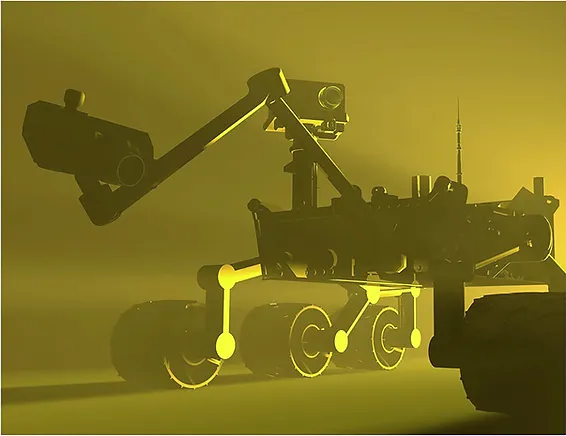
Even with the addition of a strange mineral, robots still obey the principle of bounded rationality in artificial intelligence set forth by Herb Simon.
I cover bounded rationality in my Science Robotics review (image courtesy of @SciRobotics) but I am adding some more details here.
Did you like the Western True Grit? Classic scifi like The Martian Chronicles? Scifi horror like Annihilation? Steam punk? How about robots? If yes to any or all of the above, The Strange by Nathan Ballingrud is for you! It’s a captivating book. And as a bonus, it’s a great example of the real world principle of bounded rationality.
First off, let’s talk about the book. The Strange is set in a counterfactual Confederate States of America colony on Mars circa 1930s, evocative of Ray Bradbury’s The Martian Chronicles. The colony makes money by mining the Strange, a green mineral which amplifies the sapience and sentience of the Steam Punk robots called Engines. The planet is capable of supporting human life, though conditions are tenuous and though the colony is self-sufficient, all communication with Earth has suddenly stopped without a reason and its long term survival is now in question. The novel’s protagonist is Annabel Crisp, a delightfully frank and unfiltered 13 year old heroine straight out of Charles Portis’ classic Western novel, True Grit. She and Watson, the dishwashing Engine from her parent’s small restaurant, embark on a dangerous trek to recover stolen property and right a plethora of wrongs. Along the way, they deal with increasingly less friendly humans and Engines.
It’s China Meiville’s New Weird meets the Wild West.
Really.
What makes The Strange different from other horror novels is that the Engines (and humans) don’t exceed their intrinsic capabilities but rather the mineral focuses or concentrates on the existing capabilities. In humans it amplifies the deepest aspects of character, a coward becomes more clever at being a coward, a person determined to return to Earth will go to unheard of extreme measures. Yet, the human will not do anything they weren’t already capable of. In robots, it adds a veneer of personality and the ability to converse through natural language, but Engines are still limited by physical capabilities and intrinsic software functionality.
The novel indirectly illustrates important real world concepts in machine intelligence and bounded rationality:
- One is that intelligence is robotics is tailored to the task it is designed for. While the public assumes a general purpose artificial general intelligence that can be universally applied to any task or work domain, robotics focuses on developing forms of intelligence needed to accomplish specific tasks. For example, a factory robot may need to learn to mimic (and improve on) how a person performs a function, but it doesn’t need to be like Sophia and speak to audiences about the role of artificial intelligence in society.
- Another important distinction is that the Public often conflates four related but separate concepts: sapience (intelligence, expertise), sentience (feelings, self awareness), autonomy (ability to adapt how it executes a task or mission), and initiative (ability to modify or discard the task or mission to meet the objectives). In sci-fi, a robot may have all four, but in real-life they typically have very narrow sapience, no sentience, autonomy limited to the tasks they are designed for, and no initiative.
These concepts fall under a larger idea first proposed in the 1950s by Herb Simon, a Nobel Prize winner in economics and a founder of the field of artificial intelligence- the idea is bounded rationality. Bounded rationality states that all decision-making agents, be they human or machine, have limits imposed by their computational resources (IQ, compute hardware, etc.), time, information (either too much or too little). For AI and robots the limits include the algorithms- the core programming. Even humans with high IQs make dumb decisions when they are tired, hungry, misinformed, or stressed. And no matter how smart, they stay within the constraints of their innate abilities. Only in fiction do people suddenly supersede their innate capabilities, and usually that takes something like a radioactive spider bite.
What would our real-world robots grow into if they were suddenly smarter? Would they be obsessive about a task, ignoring humans all together, possibly injuring or even killing them as the robots went about their tasks-sort of making OSHA violations? Would they hunt us down and kill us in one of the myriad ways detailed in Robopocalypse? Or would they deliver inventory, meals, and medicine with the kindly charm of an old-fashioned mailman? Would the social manipulation in healthcare and tutoring robots become real sentience, real caring?
Bounded rationality says it depends on us. The robots will simply do whatever we programmed them for within the limits of their hardware and the situation. Of course, that’s the problem- our programming is imperfect and we have trouble anticipating consequences. But for now, even if there was the Strange on Mars, Curiosity and Perseverance would keep on keeping on. And a big shout out to NASA- It’s hard to imagine how they could work better than they already do.
Pick up a copy of The Strange, it’s a great read. Plus Herb Simon’s Sciences of the Artificial. And don’t forget my books too! You can learn more about bounded rationality in science fiction here, in my textbook Introduction to AI Robotics and more science fiction that illustrates how robots work in Robotics Through Science Fiction and Learn AI and Human-Robot Interaction through Asimov’s I, Robot Stories.
Source: Robonhub
Source Link: https://robohub.org/the-strange-scifi-mars-robots-meet-real-world-bounded-rationality/